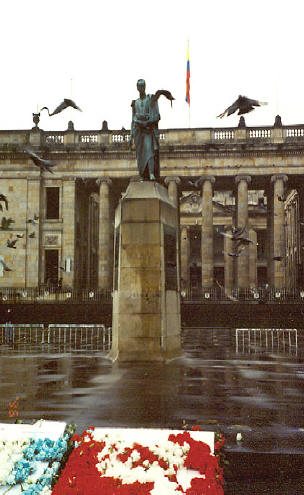|
||||||
|
History
Pre-Columbian cultures existed in scattered pockets in the Andean region and on the Pacific and Atlantic coasts. Among the most outstanding were the Tayrona, Sinú, Muisca, Quimbaya, Tierradentro and San Agustín. Many of the tribes produced accomplished goldwork and pottery, and some left behind burial chambers and rock paintings which have helped anthropologists piece together their cultures.
Alonso de Ojeda, a companion of Christopher Columbus, landed on the Guajira Peninsula in 1499. The wealth of the local Indians promulgated the myth of El Dorado, and the shores of present-day Colombia became the target of numerous expeditions. The Indians originally tolerated the arrival of the Spaniards but rebelled when the colonists tried to enslave them and confiscate their lands. Soon, a large part of what became Colombia had been conquered by the Spanish, and a number of towns, including Cartagena (founded in 1533), were prospering.
In 1544, the country was incorporated into the viceroyalty of Peru, where it remained until 1739 when it became a part of New Granada (comprising the territories of what are today Colombia, Venezuela, Ecuador and Panama).
Along with slavery, the Spanish monopoly over commerce, taxes and duty slowly gave rise to protest, particularly towards the end of the 18th century. It was during this period that the first stirrings of national autonomy occurred, but it wasn't until 1819, and the appearance of Venezuelan liberator Simon Bolívar and his army, that independence was achieved. Ten years of uneasy confederation with Venezuela and Ecuador followed in the form of Gran Colombia, until regional differences between the three finally undermined the union. |
|
|
Political currents born in the struggle for independence were formalized in 1849 when two parties (dominated by creole elites) were established: the Conservatives with centralist tendencies and the Liberals with federalist leanings. The parties divided the nation into partisan camps, which eventually heralded insurrection, civil chaos and war. In the course of the 19th century, the country experienced no less than 50 insurrections and eight civil wars, culminating in the bloody War of a Thousand Days in 1899.
After a period of relative peace, the struggle between the Conservatives and the Liberals broke out again in 1948 with La Violencia, the most cruel and destructive of Colombia's many civil wars. Close to 300,000 died in the conflict as the Conservatives tried to consolidate a new era of power. When it became evident that the conflict was developing revolutionary overtones, both parties decided to support a military coup as the best means to retain power and rein in the growing band of rebels camped in the countryside. The resulting coup - by General Gustavo Rojas in 1953 - proved the only military intervention Colombia has experienced this century. It was shortlived, however, falling in 1957 when the Liberals and Conservatives agreed (now under the guise of the National Front) to share power for the next 16 years.
The National Front formally came to an end in 1974, when Liberal President Alfonso López Michelsen was elected, but a modified version of the two-party system continued for another 17 years. In the meantime, the political monopoly encouraged the emergence of a number of left-wing guerrilla groups such as the National Liberation Army (ELN), Revolutionary Armed Forces of Colombia (FARC) and the April 19 Movement (M19). They failed to dislodge the government, but undermined its ability to govern properly.
Another pressing threat was the setting of paramilitary death squads against any group (regardless of political persuasion) that sought to oppose the powerful drug cartels in Medellín and Cali. By 1990, escalating violence (increasingly leveled at members of the ruling political class) threatened to bring the country to a standstill. A new constitution came into effect in 1991 which provided greater judicial powers and strengthened government control. In June of that year, Pablo Escobar, head of the Medellín cocaine cartel and alleged mastermind of the bloody campaign of terror, surrendered. A year later, he escaped, but was finally located and killed in December 1993.
Drug trafficking continues to grow (courtesy of the pragmatic Cali cartel), bringing in an estimated US$5 billion a year. The arrest of Cali cartel leader Gilberto Rodriguez Orejuela in June 1995 was a feather in the government's cap but did little to radically alter the dynamics of the Colombian drug trade. Even then-president Ernesto Samper was forced to spend much of his last years in office refuting allegations that drug money financed his election campaign. Samper's Liberal Party succesor, Horacio Serpa, lost the June 1998 presidential election to conservative Andres Pastrana, who in 1994 had blown the whistle on Samper's Cali connections.
Despite strong economic growth from 1993 through to 1996, 'things' continue to go wrong for Colombia. According to SIPRI, el Instituto Internacional de Investigaciòn Sobre Paz, the internal conflict in Colombia is amongst the 10 most bloody in the world and last year almost equalled that of Yugoslavia. The government has suspended peace talks with guerrillas indefinitely. In 2000, the United States approved $1.3 billion in aid to support the Colombian government's struggle against the guerrillas. |
|

